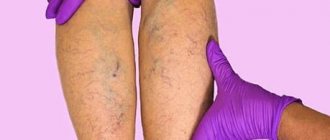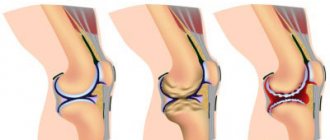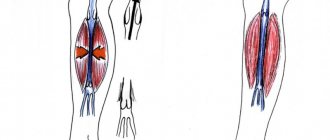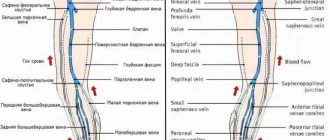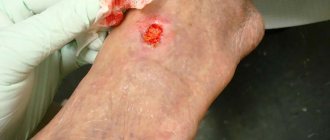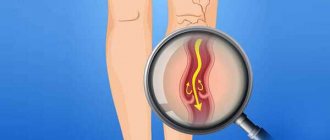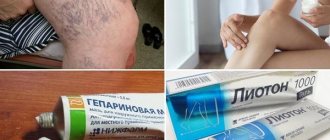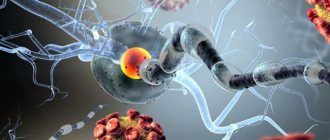Paresthesia
Paresthesia is a type of sensitivity disorder when tingling and other unpleasant sensations suddenly occur in one or another part of the body.
Types and causes of paresthesia
Transient paresthesia of the limbs is probably familiar to every person. When, after sleeping or sitting for a long time in an uncomfortable position, a tingling sensation is felt in the leg or arm - from mild to quite strong. This condition usually goes away within a few minutes and does not cause significant discomfort. In this case, the reason lies in temporary mechanical irritation of a nerve located close to the surface of the skin, or in a disruption of the blood supply.
But sometimes paresthesia occurs for no apparent reason and persists for a long period of time. Moreover, it is not only the arms and legs that can bother you; there may be numbness in the face, lips, chin and other parts of the body. In this case, the etiology depends on the type and location of the lesion.
Paresthesia of the legs can be a consequence of:
- osteochondrosis of the lower spine;
- multiple sclerosis;
- spinal cord injuries;
- lumbar radiculopathy;
- obliterating endarteritis;
- polyneuropathy;
- kidney or liver diseases;
- connective tissue pathologies;
- spine surgeries, etc.
Paresthesia of the hands and fingers is often caused by:
- osteochondrosis;
- peripheral nerve disorders, such as carpal tunnel syndrome;
- inflammation of the neck muscles;
- multiple sclerosis;
- neck injuries;
- Raynaud's disease;
- syringomyelia;
- neoplasms;
- stroke, etc.
Paresthesia of the tongue occurs due to malocclusion, wearing dentures or sharp edges of the teeth. However, sensitivity disturbance occurs with the simultaneous presence of internal factors, for example, diseases of the ENT organs or the digestive system.
The causes of paresthesia of the face, head, lips can be:
- exposure to high temperatures;
- neuritis of the facial nerve;
- migraine;
- cerebral ischemia;
- cervical osteochondrosis;
- inflammatory lesions of the oral cavity;
- hypertensive crisis.
Other probable causes of any type of paresthesia: prolonged stress, magnesium deficiency, intoxication of the body with heavy metals or toxic substances.
Paresthesia is one of the side effects of a number of medications (antibiotics, antihypertensives, antituberculosis and antiepileptic drugs).
Chronic paresthesia is usually a sign of damage to the nervous system. The root causes include tumors, infectious diseases (for example, HIV infection), autoimmune pathologies, etc. Secondary lesions develop if the patient has atherosclerosis, diabetes mellitus, hypovitaminosis, alcoholic polyneuropathy, etc.
Folk remedies
Photo: xcook.info
Folk remedies will not eliminate the cause of the development of paresthesia, but will help alleviate the symptoms and, thereby, improve the general condition of the person.
First of all, you should carefully monitor your lifestyle and diet. It is recommended to stop smoking and drinking alcohol, and not to abuse hot and spicy foods. Jerusalem artichoke has a good effect (helps eliminate numbness due to its beneficial effect on nerves and blood vessels).
Medicinal baths and contrast baths are also used. To prepare a medicinal bath, you can use herbs such as sage, chamomile, and string. The water temperature should not be hot, but comfortable for humans. Reception time is no more than 15 minutes. You can complement the effect with a massage with warming cream, which is performed immediately after taking a bath.
Contrast baths will help improve blood circulation and increase muscle tone. To carry out the procedure, you should prepare 2 basins with hot and cold water. The essence of the procedure is to alternately lower the feet into one and then into the other basin.
You can purchase a massage roller or brush for daily use. This kind of massage helps improve blood circulation and reduce the symptoms of paresthesia. But you should not massage areas of the body for too long and actively, so as not to injure the skin and cause irritation.
Soothing infusions of medicinal herbs have a good effect, since one of the reasons for the development of paresthesia is psycho-emotional stress. Herbs such as motherwort, mint, chamomile, adonis, and lemon balm are suitable for this. Decoctions are taken during the day in 3-4 doses. The course of herbal treatment lasts no more than 1 month, then a break is taken for several weeks, after which, if necessary, the course is repeated.
The information is for reference only and is not a guide to action. Do not self-medicate. At the first symptoms of the disease, consult a doctor.
Symptoms
Muscle paresthesia is manifested by three classic signs: numbness of varying severity, a sensation of “crawling” on the skin and tingling.
Sometimes the skin turns pale, a burning sensation appears, and the local temperature decreases.
These symptoms may occur sporadically. But if there is a serious reason, the intensity of the manifestations may increase, until the appearance of pain. Exacerbations are replaced by periods of calm, then the disease worries again. But in some cases (for example, with multiple sclerosis), paresthesia becomes continuous and worries constantly.
Numbness in left leg
A feeling of numbness in the left leg in the absence of other symptoms is a dangerous sign, a possible prerequisite for a stroke or ischemic attack.
Numbness of the fingers, one or more, indicates neuropathy of the tibial and peroneal nerves, the presence of an intervertebral hernia. When dislocated in the area of the fifth vertebra, the hernia can, in addition to numbness, cause tingling, cottoniness and mild pain along the outer part of the lower leg. If the symptoms are supplemented by redness, swelling, or limited mobility of the limb, a cardiological or rheumatological examination is necessary. The femoral part of the left leg goes numb due to degenerative-dystrophic processes associated with pinched nerve fibers. Numbness in the lower leg indicates damage to the spine, especially if it worsens with physical activity.
Diagnostics
For a preliminary diagnosis, the doctor only needs to interview the patient, clarify the nature of the unpleasant sensations and the frequency of their occurrence, and collect an anamnesis.
The main goal of diagnosis is to establish the immediate cause contributing to the occurrence of paresthesia. Often, it is thanks to this disorder that doctors are able to diagnose serious diseases, such as diabetes.
If necessary, carry out:
- blood tests (biochemical, sugar levels and toxin levels);
- Dopplerography of blood vessels;
- electroencephalography;
- Ultrasound of the heart;
- radiography of the spine;
- computer or magnetic resonance imaging of the brain and/or spinal cord.
Patients are often prescribed electroneuromyography - this method allows one to determine the speed of impulse propagation along the nerve fiber, and therefore detect disturbances in nerve conduction.
Causes of inflammation of the trigeminal nerve on the face
Usually the disease is caused by infection or bacteria. List of reasons why inflammation of the facial nerve may occur:
- Temporomandibular joint injuries
- Tumors (benign and malignant) of the brain and facial area
- Anomalies of skull development
- Skull injuries - birth, fracture, base, damage to the face or jaw
- Polio
- Pulmonary tuberculosis
- Otitis
- Sinusitis
- Chronic caries
- Inflammation after tooth extraction or treatment
- Hypertension
- HIV and AIDS
- Poisoning
- Inflammation of the middle ear
- Severe hypothermia of the head
- Changes in hormonal levels in women
- Gum inflammation
- Ramsay Hunt syndrome
- Stroke
- Bell's palsy
Causes range from minor to life-threatening illnesses. Each of the reasons determines the further treatment of the patient. In some cases, special tests are performed for diagnosis - auditory, lacrimal, infectious, salivary or gustatory. In this way, the functioning of the receptors and sensory organs is checked.
Treatment
If sensory disturbance is a frequent concern, this condition almost always indicates the presence of some serious pathology, so treatment of paresthesia is primarily aimed at eliminating its cause.
Patients with diabetes should adjust therapy to normalize blood sugar levels.
In case of poisoning by poisons or chemicals, detoxification therapy is carried out.
If mechanical compression of the nerve ending is detected, surgical intervention is required.
The doctor determines the pills needed for paresthesia for each patient individually. Depending on the circumstances, these may be the following medications:
- Vazonit, Flexital - products that improve microcirculation in areas of impaired blood supply;
- Magne B6 and Magnerot are magnesium preparations that inhibit excitation processes in the central nervous system and reduce the body’s sensitivity to external stimuli;
- Finlepsin is an anticonvulsant drug that stabilizes the membranes of overexcited neurons;
- Cinnarizine is a calcium channel blocker that affects primarily the blood vessels of the brain.
To improve local blood flow, antiplatelet agents (for example, acetylsalicylic acid) may be prescribed.
If the reason lies in a violation of impulse conduction, it is necessary to take B vitamins (thiamine, cyanocobalamin).
Physiotherapeutic methods help to quickly eliminate unpleasant symptoms: acupuncture, massages, mud applications, electrophoresis, etc.
Medicines
Photo: posleudaleniya.ru
Of the B vitamins, preference is given to thiamine (B1) and cyanocobalamin (B12). It is better to use it as intramuscular injections to achieve the required concentration of the vitamin in the blood.
If there is a concomitant disease that increases the risk of developing blood clots, antiplatelet drugs (for example, aspirin) are prescribed. The action of this drug is aimed at preventing the formation of a primary blood clot by inhibiting the process of platelet adhesion. This helps improve blood circulation, as a result, eliminating the feeling of numbness.
Of the antihypoxants, Actovegin has a good effect. This drug consists exclusively of physiological components that are normally present in the human body. The active substance is a deproteinized hemoderivative of calf blood. Every cell in the body needs oxygen, which is used as energy. Actovegin stimulates oxygen consumption by the cell, thus exhibiting its antihypoxic effect.
One of the representatives of antioxidants is vitamin E. It is the main fat-soluble antioxidant that protects fatty acids in and around cells from free radicals and lipid oxidation. Often used in combination with another antioxidant, vitamin C. This vitamin protects muscle and nerve tissue from the effects of free radicals.
Frequently asked questions about paresthesia
Which doctor treats paresthesia?
It all depends on the cause of the sensitivity disorder. For your first consultation, you can contact a neurologist. If necessary, he will give a referral to the right specialist.
How to determine paresthesia?
The main symptom is tingling in the affected area. It is often accompanied by numbness and a crawling sensation.
Where is paresthesia most common?
In most cases, sensitivity is impaired in the legs and arms. But in certain cases, discomfort can occur in different parts of the body, including the face.
Accompanying illnesses
Paresthesia often develops against the background of such pathologies:
- sciatica;
- cervical spondylosis;
- diabetic neuropathy;
- transverse myelitis;
- restless legs syndrome (tingling and burning in the legs).
If complications occur, the disease can progress rapidly. Therefore, patients with these diseases should undergo periodic medical examination.
Prevention
In order to eliminate such a manifestation as numbness of the legs, you must adhere to simple rules, which are as follows:
- Rejection of bad habits;
- Reducing salt intake;
- Active lifestyle;
- Proper, balanced nutrition;
- Providing the body with all the microelements and vitamins it needs;
- Avoiding high-heeled shoes or keeping them to a minimum;
- Sports activities;
- Attention to your health;
- Timely seeking professional help if certain symptoms occur.
MC CELT specialists give a positive prognosis for timely treatment of numbness in the legs. Trust your health to professionals!
Make an appointment through the application or by calling +7 +7 We work every day:
- Monday—Friday: 8.00—20.00
- Saturday: 8.00–18.00
- Sunday is a day off
The nearest metro and MCC stations to the clinic:
- Highway of Enthusiasts or Perovo
- Partisan
- Enthusiast Highway
Driving directions

